#merino blue/white
Explore tagged Tumblr posts
Text


First chain-ply! OMG it feels SO soft and yet firm - I am very confident in the integrity of this yarn.
#navajo ply#chain plying#drop spindle#yarn#fiber arts#hell yesssss#cannot wait to knit with this#merino blue/white
8 notes
·
View notes
Text
My sweater plans for the nearest future are
The Sock Yarns Abomination One
The Bright Bright Green (where I need to see if the same yarn in what I'm gonna call the Yelling Pink is available, because the idea of all ribbing in a contrasting colour is oh so tempting)
The Neon One. Yellow with green ribbing. Maybe also green transitioning into yellow on the sleeves through colourwork, but I need to ask myself if I actually have the energy for that
Extremely Thick Bright Cardigan. Cyan+magenta stripes. 10mm needles. Need I say more?..
And YES most of them worked in good ole stockinette. I'm not ambitious with my Relaxed Time Knits. Also if my knits don't require me to look at a pattern, it's so so much more definite that I WILL knit them more. Like there's this lovely sweater WIP I got lying by my side, but... What am I more likely to grab for 10 minutes of knitting while waiting for Dungeon Queues in FFXIV: the loveliest sweater that has an expansive cabled pattern in the middle, or my dearly beloathed shrug on 2.5mm needles that has an EXTREMELY memorable pattern and is bound to get faster when I get to 2x2 ribbing in 20 rows??
#shut up kevin#craftsy talks#knitting#there's now also another Mindless Knitting piece waiting for me to be done so that's for later#because it's a delight to the senses in the form of a top down raglan that has almost tge entire body complete#and it's alpaca+mohair held double WITH AN OMBRE from gold on the top to muted orange on the bottom#and the section of these two together is so nice#I don't want to think about the logistics of where I'll dry my projects though (but given the LOW humidity in the air they'll dry just fine#at some point I also WILL dig up that lovely blue-orange-lavender-white merino.. for a sweater#but I'm on the Either Bright Or Speckled (Better When Both) path right now#and by the Twelve I'm not having enough time to knit what's in my NEAREST plans#and the pretty yarns keep calling my name.. and calling me names if I don't pick them up which hurts actually :(
2 notes
·
View notes
Text
update on my knitting journey: casting off is still hell and i'd rather someone else do it for me or the hems magically finish themselves in all garments (is this why i prefer cuff down socks SO MUCH over toe up??? no stretchy cast off trials??), but! i have learned maybe? and decided not to cast off now, at midnight, while exhausted and annoyed at the idea of casting off. because i already struggle with knitting too tightly and i do NOT need an immovably stiff tight sweater hem, ever 🙃
#knitblr#knitting#i have two sweater bodies nearly done! just cast off on this one and ribbing + cast off on the other!#AND THEN WE HAVE THREE (3) SWEATERS ON SLEEVE ISLAND. SHOOT ME.#in other news i will maybe knit a white mountains sweater by midori hirose soonish (◡ ω ◡) in a dark blue or dark grey!#AND MAYBE I WILL GET FANCY MERINO SILK MOHAIR COMBO FOR THAT! WE'LL SEE!!! ᕦ( ⊡ 益 ⊡ )ᕤ#might be too warm tho
10 notes
·
View notes
Text

“Ocean View” on velvet 4ply. A relaxing mix of blues, aqua, and sea green with white surf. This yarn is spun from 87% merino wool that’s soft and warm with 13% pima cotton for additional durability, plus a wonderful velvety texture and stunning visual effect. I use dyes that bind to the wool but not the cotton for a beautiful glint of white sea spray. It’s light and open and has a lovely drape.
MothyandtheSquid.com
#mothyandthesquid#yarn#knitting#knit#yarnaddict#knittersofinstagram#crochet#yarnlove#miniskeins#yarnlover
181 notes
·
View notes
Text
Fiber arts update! Featuring handspun and pin loom shenanigans!
Remember this stuff?

Left-to-right: 6-ply 50/50 silk/polwarth, 3-ply 60/20/20 polwarth/silk/yak, 4-ply silk/polwarth (same stuff as the 6-ply) and 4-ply 70/30 merino/silk. Made a scarf out of it.
And, well, I ended up with some leftovers! A very awkward amount of leftovers, not quite enough for anything, but too much to just leave lying about, especially because this is the good stuff.
So I figured I'd weave a bunch of pin loom squares, see if it's enough for something. Picked out a cowl to make halfway through.
I then promptly realized that I was gonna come up short by a decent amount of squares because I didn't have as much blue left as I thought... but I did have the same fiber in a similar colorway on my spindle!

(old photo, I had about 13g of fiber on that thing by that point)
I thusly guesstimated that I must've spun up about half of it, and quickly got the other half done on my wheel. Two-plied it, then cabled it, expecting that to be a pretty decent match to the other 50/50 4-ply silk mix.

It was not a decent match. The other blue shit is somewhere between sport and dk.
But thankfully I'm resourceful:

Most of the white squares have 4-ply warp and 6-ply weft for some texture and a denser weave; I did two of the blue ones with the 4-ply white stuff too to stretch the blue a little further, and for the more purple-ish ones, I ended up doubling the yarn for the weft, which means they had a 4-ply warp and an 8-ply weft. We're not even gonna talk about that gray/white square.
(4-ply/6-ply square in progress):

Sewed it up and felted it a fair bit, for more sturdiness and a more cohesive fabric:

And here's the finished thing, modelled by the resident giant owl plushie:

If you're wondering, the colors are laid out like that because I wanted the softer yak hair mix in the back, where it'd be touching my nape, because I'm super super sensitive to textures there and the merino/silk mix is a bit rougher. In the meantime, this also lets me have all the fun colors at the front. Win/win!
Anyway, this was fun. I always feel kinda dodgy just whipstitching the loops together because it never seems to quite fully come together... but I really enjoyed the process here, the end product is wonderful, and I am eager for more.
#guardy's fiber arts tag#handspun#handspun yarn#hand weaving#hand spinning#yarn spinning#pin loom#zoom loom#pin loom weaving
78 notes
·
View notes
Text





I was at the Heide Wolle Fest on Sunday! First time ever ^_^
and I brought home a bunch of nice things:
2 hanks of sock yarn that will become pompom hats for the kids
100g spacy combed top in dark blue, dark green and dark yellow, probably merino?
100g pretty yellow mix combed top with merino, alpaca, angora and Cashmir
102 g blue white merino fluff called "Sturmhimmel" (i. e. "Storm Sky")
and 160 g Shetland (24 mic) by luluswolle which I have already declared a new favourite because it's soft like a cloud and I can't wait to spin it tbh xD
51 notes
·
View notes
Text
NEED TO MAKE RENT SALE
As you may have seen I'm selling some of my handspun yarn, along with some fleece, batts, rolags, and other odds and ends. I'm really short on rent this month, largely due to having so many flare up days that working was almost impossible. So, I'm selling some of my work in the hopes that I can still make rent somehow. I need over $500.
Im also linking to my kofi. If you don't wish to buy anything but still want to help me make rent--which I would appreciate so much <3
I'll be updating this post as I sell things so please make sure to click back to my original post to check if it's still available. First come first serve. Unless otherwise stated, all shipping is $5 USD to within the USA. If you're outside of the USA please let me know--shipping will likely be between $30-50 USD depending on to where, but I am happy to work with you if you're interested.
PLEASE DM ME IF YOU WANT TO BUY SOMETHING <3

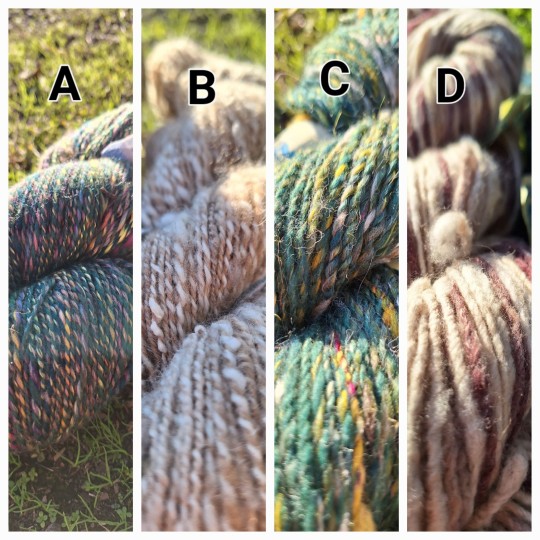
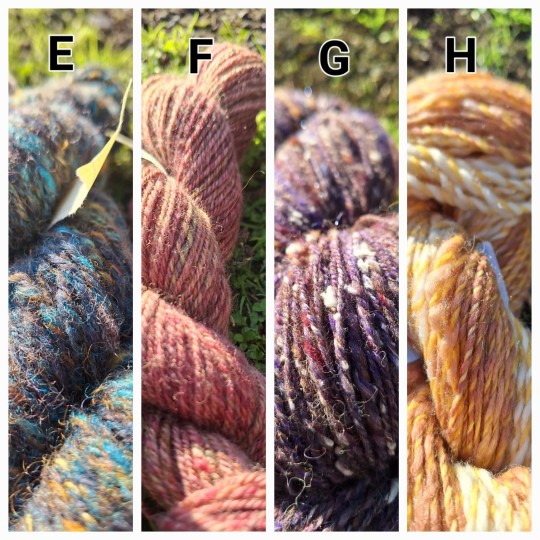
YARNS (please ignore the slips of paper, ive given everything a nice label now)
A: 572 yards/ 480 meters. 5.75 oz/ 165 grams. 2 ply, approximately DK weight. Silk and merino blend assembled by myself. There are stripes of different greens which are arranged to be bigger at one end than the other, so a triangle shawl (working from the correct end of yarn) will have stripes that are more or less even instead of getting thicker near the narrow end of the shawl. I don't know how noticeable the effect will be, though. Silky soft and shines beautifully in the sun. $100 USD or best offer.
B: 175 yards/160 meters. 2 oz/ 57 grams. 2 ply, light fingering weight to sport weight. Luxury blend of alpaca, cormo, debouillet, silk, silk noil, angora, and cashmere. Very textured due to how I plied it and some noils, but also extremely soft and with lovely drape. Next to skin soft. $60 USD or best offer. SOLD
C: 176 yards/160 meters. 2.25 oz/64 grams. 2 ply, light worsted. Merino, silk, silk noil, angora, and mystery wool blend. Next to skin soft, lots of different colors, and good drape. $50 USD or best offer. SOLD
D: 152 yards/130 meters. 2 oz/57 grams. 3 ply, light worsted. Cormo, alpaca, and merino blend. This yarn was arranged into a stripey gradient--white stripes separating a light purple to dark purple gradient. 3 ply. Incredibly soft--would be perfect for a hat or cowl. $55 USD or best offer.
E: 100 yards/91 meters. 2.5 oz/71 grams. Traditional 3 ply, aran/bulky weight. Romney 3 ply. Durable, squishy, and warm, but not particularly soft. Would make a great hat or gloves. $35 USD or best offer SOLD
F: 140 yards/128 meters. 1.75 oz/50 grams. Traditional 3 ply, fingering weight. Beautiful BFL yarn in autumn colors. Due to the traditional 3 ply the colors constantly shift and change. Very soft and with good drape. $45 USD or best offer. SOLD
G: 325 yards/300 meters. 4 oz/115 grams. 2 ply, fingering weight. Wool, silk, silk noil, alpaca, and Angelina blend. Very textured but soft and drapey. $80 USD or best offer.
H: 166 yards/145 meters. 2 oz/57 grams. 2 ply worsted weight. Targhee, BFL, Angelina blend. Incredibly soft and drapey. Fuzzy and lightly underplied for maximum softness (so a little delicate). Next to skin quality. $45 USD or best offer.
(I'll accept the highest offer I get in a timely manner, so if you really want something and think other people also want to buy it, you can offer more to potentially guarantee you get it. Or offer less, and get it for cheaper if nobody else wants it. Although I wont accept very low offers, sorry.)
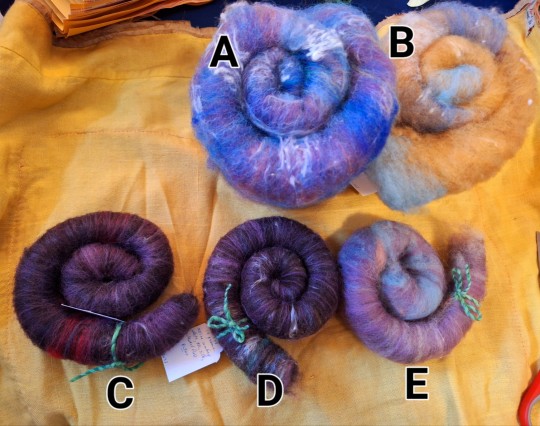

BATTS AND ROLAGS. These all contain several large handfuls of milkweed floss, because why not. Very fun and soft to spin.
A. 0.75 oz/21 grams. Romney, BFL, silk, bamboo, Targhee, milkweed floss. Somewhat soft, would be very soft if plied with a fine fiber. Lots of purples and blues, with small amounts of rainbow. Should yield a heathered, smooth yarn except for bumps of milkweed floss. $15 USD or best offer. SOLD
B. 0.75 ounces/21 grams. Naturally dyed Shetland combing waste (yellow), BFL, silk merino, milkweed floss. Many different colors arranged in stripes--yellow and blue primarily. Should yield a textured yarn due to the combing waste, but also lofty and colorful. Fairly soft and very squishy. $15 USD or best offer.
C: 0.5 oz/14 grams. Tussah silk, BFL, merino, merino combing waste, milkweed floss. Very soft. Majority tussah silk which is charcoal black. The other colors are dark purple, a few streaks of red, and the shining white from the milkweed floss. Should spin up to a fine and soft yarn. I am also able to make more of these, which would be the same weight and price and matching the original as closely as possible. Let me know if you want several. $12 USD or best offer. SOLD -- but i can make more, if youre interested !
D: 0.5 oz/14 grams. Merino combing waste, merino, BFL, silk, milkweed floss. Buttery soft. Mostly dark brown with purple, blue, and white streaks. I can make several identical ones if desired, for the same price each. $12 USD or best offer. SOLD -- but i can more, if you're interested !
E: 0.5 oz/14 grams. BFL merino, mystery wool and milkweed floss blend. This has stripes of purple and blue, suspended a squishy mystery combing waste. Should yield a fine but squishy yarn. $10 USD or best offer. SOLD
If I sell all or most of these I will make some more !
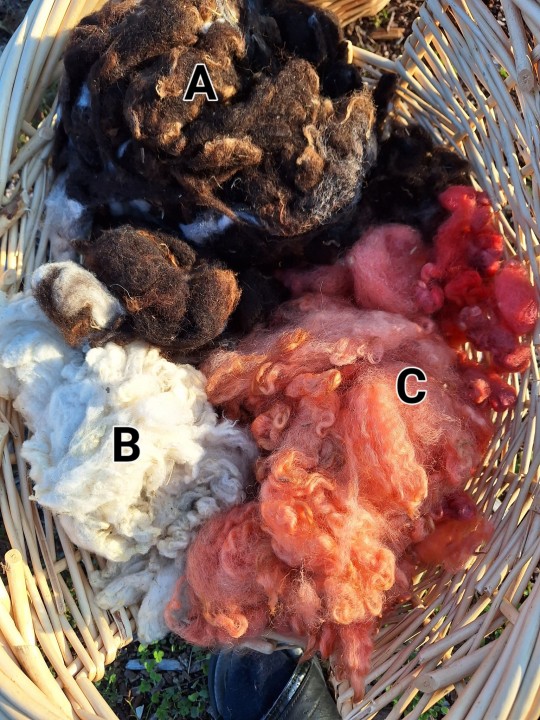
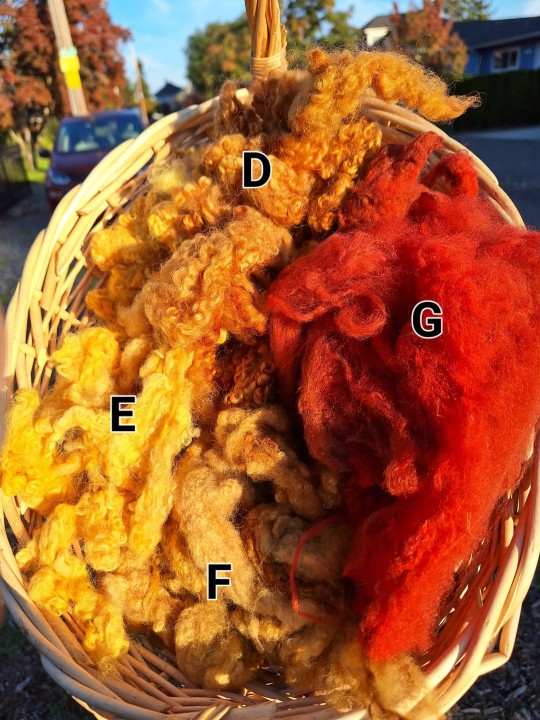
FLEECE. I am selling by the ounce (28 grams). I'm also willing to process these into fluffy hand carded rolags or fine hand combed top as desired, which will cost extra depending on how difficult the fiber is to process.
A. Jacob lambswool. Very soft but lots of large vm (so, easy to pick out) and nepps/noils. Those will stay in the fiber unless combed, so this tends to produce a very soft, bumpy yarn. I love this fleece but I just can't seem to use it up. Primarily dark brown, but I also have some white and mixed as well. I have about 8 ounces. Washed but still a tiny bit greasy (just to my preference). $3 an ounce.
B: Rambouillet. I have almost a pound of this stuff. Incredibly buttery soft. Like touching seafoam. But it has a ton of fine VM, so it can only be cleaned either lock by lock on hand cards or combed. I am willing to clean it for you. Takes a long time to get into a spinnable state but it is SO worth it. $2 an ounce. SOLD
C: Breed unknown. Some sections are salmon pink, others closer to hot pink. Not much vm, can be combed open lock by lock on hand cards or combed into top. Yields a silky, strong, hairy yarn. Willing to process for you (this would be one of the cheaper ones to do, it's very easy). I have 5 ounces. $2 an ounce. SOLD
D & E: These are both rya lambswool, naturally dyed with yellow onion skin (the bright yellow one with alum, the copper one with copper). Very soft and silky, spins up to a surprisingly robust yarn. Absolute treat to work with. Some vm but the nature of this fleece causes the vm to fall out pretty easily. I have about a pound total. Will process for you. Washed and dyed by myself. $5 an ounce. D IS SOLD, E IS STILL AVAILABLE
F: Sunshine Shetland. Very soft and fine. Naturally dyed, again with onion skins. The tips are somewhat felted and need to be pulled off, which is quick and easy. If combed lock by lock and then spun that way you can get a subtle gradient of orange to yellow with each lock... absolutely gorgeous. Will process for you. I have about 10 ounces. Washed and dyed by myself. $5 per ounce. SOLD
G: Red Hampshire. Not neon red like in the picture, more of a brick red. Very soft and foamy. Some vm. Easy to process on hand cards by combing lock by lock or turning into a rolag. Washed and dyed (using food coloring) by myself. I only have an ounce and a quarter--which is $6 for all of it. SOLD
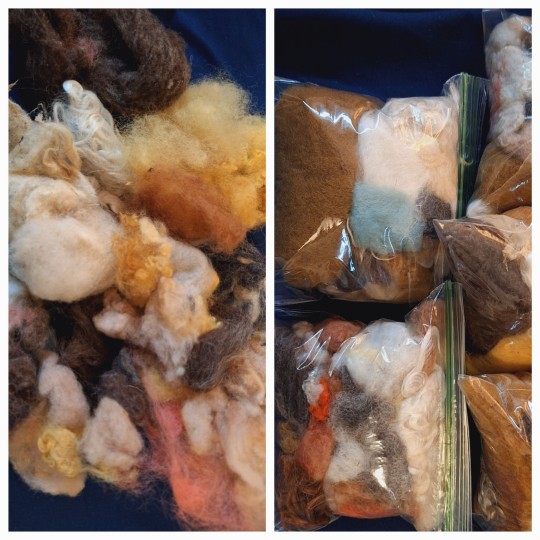
COMBING WASTE GRAB BAGS
These are 1 ounce bags of primarily combing waste (so, short fibers and likely some vm) along with other interesting scrap such as mohair locks, colorful merino, and sometimes the occasional single rolag. Lots of the colors are naturally dyed by myself. Great for turning into rolags or using for batt fodder. These are $5 USD if you're buying more than one item (that could be yarn, another grab bag, some fleece, etc) or $10 USD each if you are only buying a single grab bag.
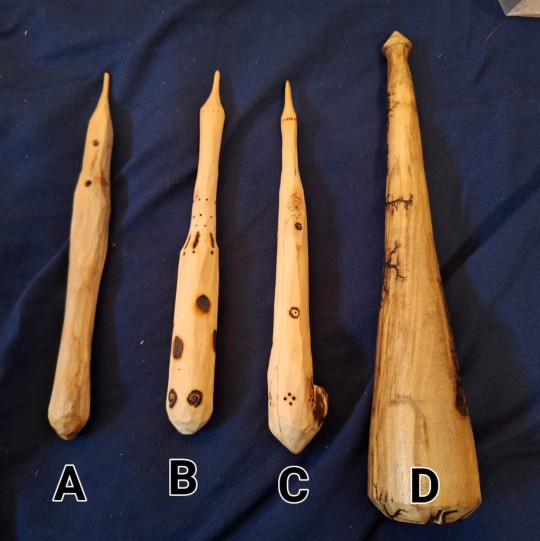

SPINDLES
Lastly, I'm also selling some spindles. A-C are whittled and decorated by myself. D is a beautiful Dealgan which I never could figure out how to use.
A. Supported spindle carved from a fruit tree. I gave it a steeple shape, which does make it slow to spin with. Really enjoyable for special spins that you want to do slowly and thoughtfully. Small spindle, about the length of my hand. $55 USD or best offer.
B. Onion dome supported spindle. Very light for its size, so it can hold a decent cop on it. Small spindle--about the length of my hand. $50 USD or best offer. SOLD ! thank you 🩵🩵🩵
C: Larch spindle. This one has lots of beautiful spalting, as well as being woodburned. Also the length of my hand. Has a very distinct feel to it, sort of in an alive way. $90 USD or best offer.
D: Lightning Dealgan. I got it for $50 and it's basically unused, so reselling for $50 USD. Very heavy and smooth.
And thats it ! If you don't want to buy anything but still wish to help me make rent, you can also donate to my kofi, which would mean the world to me <3
161 notes
·
View notes
Text
hi! ok so i'm going to talk about one of my top-five favourite things, which is: dyeing stuff! this is going to be specifically about dyeing protein fibres (animal fibres—wool, alpaca, silk, etc) in a pretty low-key way in your kitchen.
to be clear up front: this is not the most scientific, most perfectly reproducible, or most Objectively Correct way to dye things. i get a lot of fibre that i like this way, though, and i think that other people can, too.
fibre i've dyed that i think is neat:
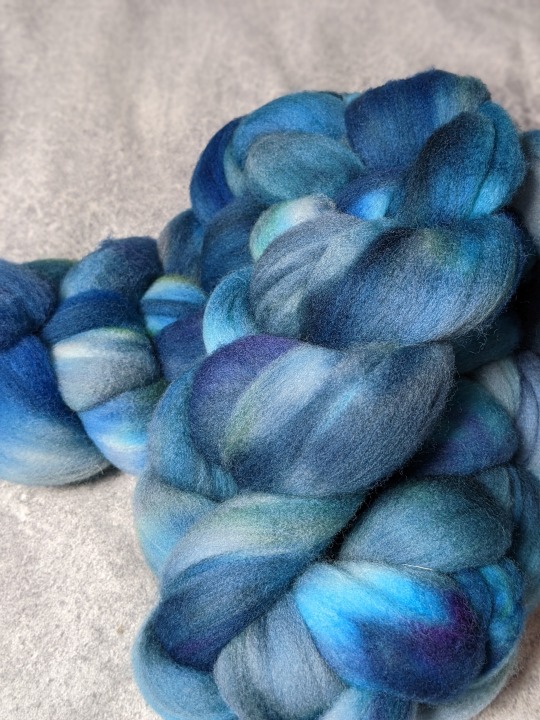


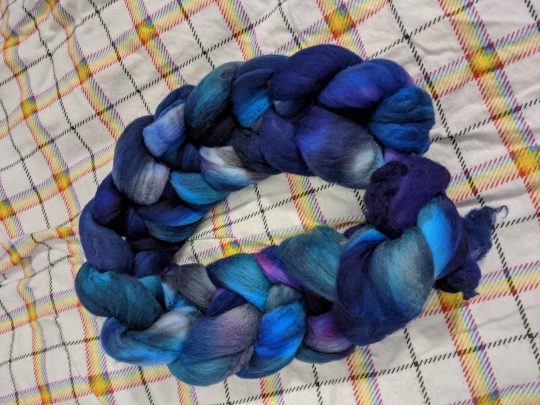
you can also dye yarn like this:
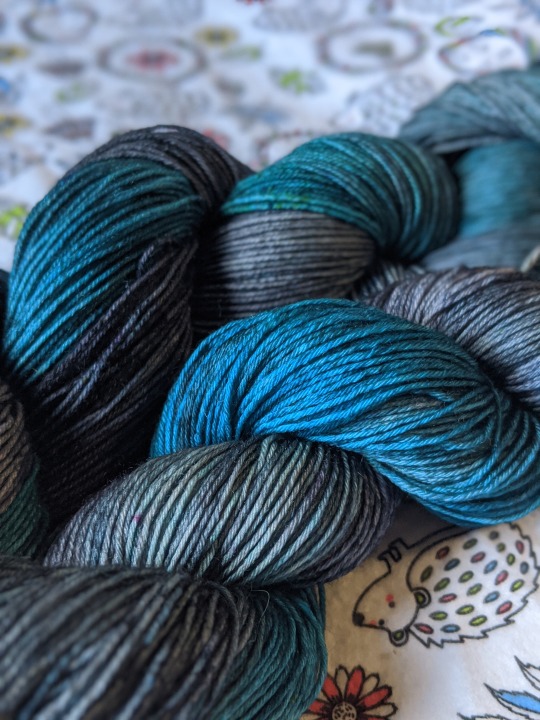
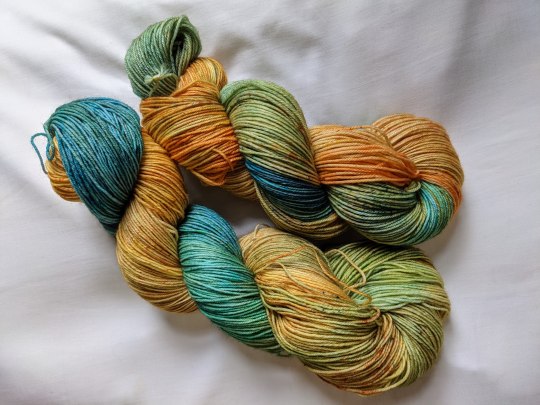
yes, i like blue a lot. i also really like variegation and heathering, which is why most of the fibre here has patches of white—it's an intentional choice that i've made. you can make different choices.
here is what you need to dye things:
fibre, vinegar, dye, a pot, heat, and some water.
that was so you don't get overwhelmed by the impending wall of text. here is what you need to dye things (it's the same stuff!), but with way more detail:
fibre or yarn. this is the big one, obviously. i tend to dye in 100-200 gram batches, because that's approximately what fits on my stovetop easily. if you're very nervous about felting or harming your fibre, you can use stuff that's been treated to be superwash, start with yarn (which is harder to felt than fibre is), or use a felt-resistant breed like dorset or suffolk. honestly, though, i learned with merino because that's what i had, and it was fine. again, though, this guide is only for protein fibres. it will not work for things like cotton. the only exception to this is nylon, which will take on some colour, but less than a protein fibre will.
a mordant. this is a fancy way of saying a thing that makes dye stick, and for what we're doing here, it's citric acid or vinegar. your grocery store definitely has at least one of them, though if you can choose, i prefer citric acid, because i love wet wool smell but i do not always love wet wool vinegar smell.
dye. i use acid dyes, and am personally deeply loyal to dharma acid dyes, but ashford and jacquard acid dyes work the same way. if you don't want to buy dye or don't have access to it, food colouring will often work, as well, though i haven't tried this with natural food colourings and have no idea how well they'll work.
a dedicated dye pot. ok, if you're doing food dyes, you don't need this. if you're not, it's definitely best practice, though i don't know how dangerous it is not to. any large metal pot will do, but my favourite option is hotel pans, which are those huge metal pan/tray things that hold food at buffets and the like. i have a full-size one that's 15cm deep, and a half-size one that's 4cm deep. they're great because they let you lay out the fibre you're working with so you can see most of it in a single layer.
dedicated dye utensils. as before, i don't know how much of a huge deal this is. i'll be honest and admit that for several years i had a single pair of tongs that got used for all tong-requiring events, including dyeing, and i'm still alive. i suggest that you have at least a big spoon, and a big spoon and tongs are even better.
something to mix the dye in. yeah, i use empty plastic sports drink or soda bottles for this. you can be fancy and get mason jars or little squirt bottles or whatever, and if you get super into dyeing you'll want to mix up dye stocks, but that's way outside the scope of what we're doing here. i like the powerade bottles that have a little squirty mouthpiece, because it's fun to squirt dye onto things.
personal protective equipment. i think this is the part of things that freaks people out. ideally, you wear plastic gloves and a mask (yeah, like your covid masks) when you're working with dye. realistically, i almost never remember to put on gloves and just accept that my hands are going to be blue sometimes. you should wear a mask, because dye is an irritant, but the world is an imperfect place and i have wicked bad adhd and sometimes i forget. this isn't advice. i'm just being honest. you should use some kind of safety stuff. you probably won't die if you don't.
you might also want some little random bits: an old toothbrush or paintbrush, a pipe cleaner, some toothpicks, etc. this is mostly if you like speckles, or if you want very small patches of colour.
so first: there are a million ways to dye things, and i'm not convinced that any of them are objectively correct. i do what i do and it works for me. some of the things i do are the opposite of what most guides suggest, but i do them because i like the effects they create.
ok, that's all the background stuff you need. let's dye some stuff!
the number one most important thing to remember when you're dyeing is this:
you can always add more colour. you cannot take it away.
that's in fancy writing and bold because every once in a while i forget this, and every single time i end up regretting it.
here is how to dye things:
put water, citric acid (or vinegar), and fibre into a pot. add dye and heat. let cool completely. rinse the fibre in cool water, then hang to dry.
like, sure, we're going to go into way more detail, but push come to shove, if you do that, you're going to end up with dyed fibre. there are a lot of tutorials telling you that you must soak your fibre first, or you must add your citric acid this way, or hold the water at exactly this temperature, and i'm here to tell you that while any of these things can give you different results, those results aren't necessarily better.
the only way that you can totally screw this up is by accidentally felting your fibre, so before i get into the way more detail part of things, i'm going to talk about that.
how not to felt your fibre
i feel like if you've read this far, you know how things felt: wool, heat, and agitation. you may also notice that at least two of these things are required for dyeing. this can be stressful! but you don't have to be afraid of it. there's only been one time that i felted something to the point that it was unusable, and that happened because i literally fell asleep for several hours while the pot was on the stove. you can avoid doing this by simply setting an alarm—this is a good idea anyhow, because you'll want to check on your dye pot!
when you're dyeing, use the lowest heat that you can while still keeping the water at a simmer. if your stove, like mine, has one burner that's wildly unpredictable and sort of out of control, you may want to look for some sort of flame diffuser, also called a flame tamer or a simmer ring. i bought one on amazon for about fourteen dollars, and it's literally just a thick metal circle. it works fine.
you can also keep the heat low by using a pot with a thick bottom, though in my experience those are expensive, and if i had one i would be using it for soup, not wool.
avoid shocking your wool—never put room temperature wool into hot water, and never put hot wool into cold water. leave your wool in the dye bath until it's cooled completely, which for me usually means overnight.
finally, obviously you have to move the fibre around some. you'll need to peek under it in the pan, and when you're done, you have to rinse it and squish out the water. try to minimise handling, though. don't run water directly onto the fibre, don't get a wooden spoon and stir your dye pot around, don't wring the fibre dry when it's done.
you're probably never going to be perfect. i often find that i lose a gram or two of wool where fibres have grabbed onto each other, or where parts of the ends clumped up. it's not really felted, just sort of compacted, but it's not great to work with, and i'd rather lose a gram of fibre than fuss with the clumpy bits.
back to how to dye things
let's take it step by step, assuming a hundred grams of fibre.
put your pan on the stove and fill it halfway with water. add either a teaspoon of citric acid or a tablespoon of vinegar. this is going to help the dye strike, or stick to the fibre. the teaspoon/tablespoon is a guideline, but one that it's fine to exceed. adding more will help the dye strike faster, which can be useful if you're trying to create blocks of colour on your fibre. i usually err on the side of a little more than the guidelines, and just eyeball this—if you feel like the dye isn't taking well, you can add more later.
add your fibre to the pan. this is the first place you have to think about what you want the finished fibre to look like! you can put it into the pan any way you want, but i suggest trying to keep it in a relatively even layer, regardless of what that layer looks like. here are some ways to get specific effects:
if you want a gradient from one end of the fibre to the other, use a rectangular pan and lay your fibre out so that the line of it is parallel to the short sides of the pan
if you want a short, repeating gradient, use a rectangular pan and lay your fibre out so that the line of it is parallel to the long sides of the pan
if you want something that starts with very close repeats that get further apart as you go down the fibre, make an approximate spiral
if you don't want A Pattern (i usually don't) just lay things out in a single layer, more or less
here comes the next exciting part! decide if you want to let your fibre soak or not. again, doing or not doing this gives you some different effects!
soaking your fibre will mean that dye takes more evenly. if you want consistent colours, you'll want to soak.
not soaking your fibre means that the dye takes less evenly. the fibre on top will have less acid available to it, spends less time in the dye bath, and also has to actually get wet before it will start to dye. i actually love doing this, and think it affords a lot of cool opportunities to play with and layer colours.
if you're soaking, leave the fibre there until it's submerged. if not, don't.
now you're going to add dye! decision time, again.
you can add dye when the water is cold, which will give you more even dye coverage, and in my experience gives the colours more time to mix together
you can add dye when when the water is hot, which will give you less even coverage, and tends to encourage the colours to stay more delineated
probably surprising no one, i tend to heat the water first unless i'm starting with a base colour or i'm doing a two-colour gradient.
time to mix up some dye
as i mentioned earlier, i'm assuming that you're using powered acid dyes for this. if you're not, this mixing up part is technically optional—but doing it gives you way more control about how and where you place your colours, so i'm going to assume that you'll do it.
i usually mix dye in some sort of empty drink bottle. regardless of what you're using, before you add dye to anything, put some water in the bottle, wipe off the lip, put the lid on tightly, and shake the bottle vigorously. if there is any leakage at all, do not use that bottle. find a better bottle. if your bottle cap doesn't seal well or if you have an empty condiment bottle that's just a little wonky or whatever, you will get dye all over the kitchen, and your landlord will be really really mad about it, and you will regret your life choices. (if you own your kitchen, you can do whatever you want, but this isn't about you and you know it.)
so you have a bottle that seals tightly! great job. dump out the water and carefully put some dye powder into the bottle. remember earlier how i said you should be wearing a mask? this is the part where you should be wearing a mask.
i know that people are reading this and going, ok, but how much dye do i put in?
my answer is put in the amount that feels right in your heart, and don't forget the number one rule of dyeing things, which is that you can always add more colour, but you cannot take it away.
this isn't a very scientific answer. most dyes have a guideline about how much to use, expressed as a percentage of the dry weight of the fibre, which is what you use to get the whole quantity of fibre dyed evenly. for dharma dyes, it's like 1.5-2%, i think ashford is 1%, and jacquard is more like 2-4%, depending on the colour.
here is the problems with doing that in your kitchen: first, using that much dye will get you an evenly dyed piece of fibre, which—for me, at least—is basically the opposite of what i want. second, and more importantly, unless you have one of those teeny tiny scales used by jewelers and drug dealers, your kitchen scale will not weigh out such tiny quantities with any accuracy. third, if you do it like this, you really have to plan what you're doing ahead of time, because there's a point after which no more dye will bind! the fibre will be like enough thank u that's it i'm good and that'll be it, so you lose some of your ability to decide that actually, you want more green.
you can probably guess, at this point, that i don't weigh the dye. once you've done a couple batches of fibre with a given brand of dye, you'll start to get the vibes for how much you should use. if you really want a guideline, for a hundred grams of fibre, start with a quarter teaspoon of a given colour. you can add more—either more of this colour or a different one—later, as desired.
put your dye in the empty bottle, and then fill the bottle partway with hot water. the amount of water doesn't really matter here, nor does the specific temperature of the water. i usually fill about 3/4 of the way, because that way there's plenty of room for this next step, which is: wipe the lip of the bottle, recap it tightly, and then shake it up real good. the dye powder is going to dissolve into the water, and you now have a bottle of dye!
if you're going for a gradient, you might want to mix up your second colour so you can add them at (basically) the same time for more even mixing. if you're not, or if you only have one mixing bottle, you can do them one at a time.
oh my god we're finally putting dye on the fibre
are you ready? it's time!!
you have basically infinite options for how to do this, and many of them will give you different effects. here are some ideas:
pour the dye all at one side of the pan. and if you don't add anything else, your fibre will fade from the colour of the dye to the natural colour of the fibre
pour two colours, one at either side of the pan. depending on how much dye you use (and remember, you can always add more), this will give you either chunks of colour surrounded by white, or a two-colour gradient
add all the dye to unheated water and mix it gently, then let the fibre soak for a few minutes longer before turning on the heat. this will give you a fairly even colour
pour randomly all over, and you'll either end up with a tonal yarn or a heathered one, depending on how much dye you're using
add the dye to the water under the dry fibre, which will sink in and take up more dye on the bottom of the fibre than the top
if your heat wasn't on before, it should be now, and you're going to let the dye hang out in the hot but not boiling water for a while. how long? well, one of the cool things about dyeing with these dyes is that they exhaust, which means that when the dye has been sucked up by the fibre, the surrounding water will be clear. how long this takes will depend on the specific dye, how much of it you used, how much mordant you used, etc. i try to check every fifteen minutes.
reminder: if you started with room temperature water, the dye's not going to start taking until the water heats up, so don't check it after fifteen minutes and freak out that nothing has happened. it is fully normal for it to take up to an hour for the dye to exhaust. don't turn up the temperature, just give it time.
yay it worked!
at this point, you have a pot of hot water with some beautifully coloured fibre in it! but maybe it's not beautiful enough. maybe you want...more colours.
that's cool as hell and you should go for it. we mentioned two-colour gradients up there, but what if you want something else?
the answer, probably obviously, is adding more dye.
first, a caveat: while you can successfully make multicoloured gradients like this, it's more difficult than you think, and if it gets messed up—all the colours bleed into each other, say—it turns into a muddy mess. my suggestion is to stick to two (or three at most!) colour gradients until you have a much better feel for what you're doing.
let's talk about ways you can add more colour. you have two options: big colour and little colour.
big colour is going to add a lot of colour—you're going to mix up the dye and pour it just like you did before, but paying more attention to places that don't have dye yet. sometimes it's the middle of a gradient, or the white splotches from random pouring, or the half of the fibre that wasn't submerged when you started. or maybe you dyed the whole thing yellow, and now you want to add a blue gradient over top. whatever!
if you don't want to freehand pour, consider buying a couple large syringes, or a bottle with a squeezy top. these are also fun because you can easily get more colour between the laid-out fibre, or even under it.
in the pictures at the start of this post, the red-and-gold top and both yarns were dyed by adding big colour.
little colour isn't going to add big patches, but is going to add speckling, tonal depth, or smaller patches of colour. all of the blue-base fibres and the yellow-and-blue yarn were dyed like this.
if you're still reading this closely, you might have caught that i just said both yarns were dyed with big colour, and that the yellow-and-blue yarn was also dyed with little colour. these are both true! the base colours of the yarn were done to make big colour, but if you look at the full-size image, there are also a bunch of speckles. you can do whatever you want! no one can stop you!
here are some ways to add little colour:
mix up some dye, but use less water. add drops of the dye, either directly onto the fibre (more dramatic!) or in the water (tonal!)
use a toothpick to grab a little bit of dye powder and drop it into the dye bath (similar to the previous one, but a little less predictable)
put on a damn facemask. take a clean toothbrush, paintbrush, or pipecleaner, and just barely touch it to the dye powder. gently flick or tap the brush to add speckles of that colour
find a salt shaker that you're never going to use for anything but this. put citric acid, salt (to make it distribute better), and dye powder into it, and shake it up (with the holes covered, please cover the holes) to make sure they're evenly distributed. gently shake this over the fibre to add speckles, but more of them, and clustered together
put a little dye in a spray bottle and gently mist the exposed fibre, kinda glazing it with colour
another thing is that if you like a natural coloured yarn with dyed speckles, you can do any of these techniques without doing big colour first. the only thing to note when doing this is that you'll want to be very sure to spread out the fibre well, and maybe to consider dyeing one side, then very very carefully flipping it over and getting the other side.
ok, now what?
let's say that you've added all the colours that you want, and you've let your bath simmer long enough that the water is clear, or nearly clear. (if it's not, check troubleshooting, below.)
put the lid on your pan and walk away. if you don't have a lid, just walk away, but it's less dramatic.
the super frustrating part here is that the safest thing to do is wait until the water and fibre is fully cooled before you do anything else.
have i ignored this? yes
has it ever gone horribly wrong? not horribly wrong, but it's definitely caused me to lose an inch or two of roving on occasion
is it way more stressful if you don't wait? absolutely yes
honestly maybe just go to bed and deal with your fibre in the morning
so now let's say that it's morning and you slept long enough that your water and fibre are both room temperature, which often actually feels quite cool on your hands.
you have to drain your fibre. there are two ways to do this:
lift the fibre out of the water. this has the upside of not risking dumping your beautiful fibre into your sink, and not needing to maneuver a full pot of water, both of which are admirable. the downside is that wet fibre is fragile, and you'll want to be careful to support it.
dump the water out of the pan. this has the upside of minimising how much handling you're doing of the fibre, as well as (in my opinion) making rinsing easier. the downside is attempting to keep the fibre into the pot while you dump the water into the sink, and also needing to carry around a full pot of water.
secret third option: dump the fibre (and the water) into a strainer. upside: very easy, and you can keep the fibre in the strainer while you rinse, minimising both how much it needs to be handled and the weight on the fibre. downside: i never remember that this is an option until i'm already elbows-deep in acidulated water, discovering every tiny cuticle tear.
you're going to fill your dyepot with water again so that you can rinse the fibre. you want to minimise thermal shock, so keep the water temperature as close to the temperature of the fibre as you can, and don't run the water directly onto the fibre. i like to pull all the fibre to one side of the pan, and fill the pan on the other side.
side note: if you, smart person, remembered that you can use a colander, simply fill a pot with water, put the colander in the pot, and gently agitate the colander.
if you, person who is deeply relatable, did not remember you can use a colander and now have a pot with clean water and fibre, gently move your fibre in the water to encourage any excess dye and also citric acid to get out of there.
drain your fibre again, and this time, you're going to squeeze it dry. you're still trying to minimise agitation, so this isn't a 'wring it out' situation, it's a 'gently squish it between your hands and/or a hand and the side of the pot' situation.
hang your fibre to dry. remember what i was saying earlier about it being fragile? let me suggest, here, that you do not simply drape the entire length over a single hanger or something and hope for the best. if you literally have a single hanger, at least drape it back and forth a bit, but better if you can use more than one hanger, or a clothes drying rack, or that weird metal wine rack thing that came with your fridge that you've never used, or whatever.
important reminder: drip-drying things will make your floor wet! if you live somewhere very clear with no major roads or pollen nearby, you can probably dry things outside, but if you don't, you'll probably want to position the drying rack in a bath, shower, laundry area, or otherwise over something that will catch and/or absorb the water.
how long it takes for the fibre to dry is another unknowable variable. if it's warm and dry where you are, it might literally be overnight. if it's damp and cool, it can take days. the batch i posted a couple days ago literally took almost a full week to dry. spread it out as best you can, gently squeeze out the water you can, and otherwise you just have to wait.
you're done!
when it's dry, that's it, you're done! you might find that you need to pick off some little lint balls or a bit of compacted or slightly felted fibre from the tips, but other than that, you should be good to go.
like most fibre stuff, this is best maintained by handwashing in cool water. you may see a little bit of dye or colour loss the first time you wash it, which is pretty normal and nothing to worry about.
congratulations! you made it to the end of this incredibly long post, and if you followed along, you've just dyed some fibre!
troubleshooting
this isn't dyed enough! i want more colours!
add more dye! i'm not the boss of you.
this is true even after the fibre is all done and dryed. there's nothing that says you can't dye it again—you can, and i have.
some fibre seems to require more dye than others. silk, for example, dyes beautifully with acid dyes, but also needs way more dye than i expect it to.
remember that if you're dyeing something that's a wool/cotton blend, for example, the cotton isn't going to dye. the only exception is nylon, which will kinda dye, but not as dramatically. this guide will not work for plant fibres.
this is too dyed! i want fewer colours!
please refer back to the number one most important thing about dyeing, which—as you know—is: you can always add more colour, but you cannot take it away.
pull out some more fibre and try again. this has a learning curve, just like any other fibre craft.
these colours don't look like i expected!
this can be about a lot of things.
colour guides, especially if you're looking at them online, aren't always very accurate.
colour guides tend to assume that you're dyeing a single colour at the suggested dye percentage of weight, and using less than that will give paler colours.
dyes, especially if you're mixing brands, can interact with each other and behave in ways you didn't expect.
dyes can also break, which is when they split into their component colour molecules. this happens commonly with blacks and browns, food colouring, and anything that dharma trading has marked as 'advanced'. some people find this very desirable and seek it out; some people are very frustrated by it.
the ph of your water can sometimes affect your dye. i've been lucky enough that i've only lived places with lead problems, not weird ph stuff, so i haven't investigated this closely, but if you're consistently not getting the results you expect, even going for a single, solid-colour dye, look at the ph.
my dye water's not clear!
if you used a quarter teaspoon of dye and a hundred grams of fibre, and it's been, say, 45 minutes of actually hot water and your water still isn't clear, you probably didn't use enough mordant, and you should add some more citric acid or vinegar to encourage the dye to get in there and do its thing.
if you used you used more like a teaspoon of dye, or if the citric acid doesn't change anything, you used too much dye for your fibre. you can either shrug and pour it down the drain, or you can add some more fibre and dye that, too.
my rinse water's not clear!
you probably used too much dye. it's ok—just keep rinsing it, gently, until it's more or less clear.
some colours just like to run—you know how every once in a while you get a yarn and it just bleeds a little bit every time you wash it? sometimes it's just like that. i wouldn't worry about it too much.
my fibre has felty/clumpy bits!
a little bit of this is normal, especially at the ends of a fibre that felts easily (this means you, merino!)
pick off the bits that you don't like—this is generally fairly easy, and involves very minimal fibre loss. i don't bother doing it until i sit down to spin, and then just pull off bits as i come to them.
if there's a lot of felty/clumpy bits, more than you can reasonably pick out, you agitated the fibre too much. there's not much for this other than trying to card it out, which may or may not work.
sometimes this happens because your stove got weirdly aggressive and boiled your fibre. especially for wool that's prone to felting, the bubbling and jostling can be enough to encourage more clinginess than you'd like.
i want my dyeing to be reproducible!
this is kinda doable. it's a handmade thing, so it's always going to have some natural variance, but you can do it.
buy a jeweler's scale that measures in fractions of a gram.
start measuring your dye and acid, and take detailed notes about what you do.
follow those notes in the future, and you'll be probably 90% of the way there.
i want to dye with natural dyes!
i fully support this and have played around with it a little bit myself, but absolutely do not know enough about it to advise you.
the internet is very large and full of many people who are much smarter than i am, and i feel confident that at least one of them is desperate to tell you all about how to do natural dyeing.
i am, at this point, not that person.
i want to dye plant fibres!
i am begging you to find another guide, because this one will not work.
you didn't answer my question!
that's what my inbox is for
i have to reiterate that i'm just a person with real specific interests who started dyeing things because i couldn't find or afford the kinds of colourways that i wanted.
i am not a professional
i will do my best to answer questions, but sometimes the answer is 'just fuck around until you find out'
plant fi—
shhhhh
the end
thank you for reading this incredibly long post! i might make another one in the near future, either so i can show pictures or because i took out an entire section about how to choose colours and pick a colour scheme and work with colours, and i kinda want to talk more about that, but this is no joke almost six thousand words long, so i thought, you know. maybe not tonight.
anyhow, i hope that this was useful to someone! thank you for letting me talk about one of my very favourite things.
#dyeing#craftblr#fiber arts#fiber craft#fibre arts#fiber#fibre#dyeing wool#i'm sorry this is so long#it kinda got away from me#i just want to tell people about cool stuff!#and then talk about the cool stuff for an unreasonably long time#you know#like a normal person#anyhow this was fun#dyeing is super fun and you should try it#sorry to say that i am Not editing this#because i only edit things when people are paying me for them#but i did make my wife read it to make sure i got all the main stuff#so we should be good#still: sorry for any stylistic inconsistencies#smartest raccoon i know
316 notes
·
View notes
Text

'A navy blue piece elevates almost any ensemble.'
Hell yes!
From Hackett London Instagram - caption -
'Matthew Goode is going for a lovely dark blue merino wool and silk denim shirt, paired with a sky blue checkered stretch blazer for the chilly afternoon, while Jenson Button dons a modern classic linen Délavé Hopsack blazer with a white linen shirt.
#HackettLondon#HowToHackett#HackettSS24
Photographer: @tomcraig Creative Agency: @dentsucreative.es Production: @ko_collective Make-up: @petransellge Stylist: @verydavidbradshaw'
40 notes
·
View notes
Text



Pumpkin Spice Shawl
another absolute favorite that I've made-- I love the orange and white and how the eyelet lace and garter stitch segments allow the color variegation to show off lol
Yarn: Blue Moon Socks That Rock (100% merino wool)
Measures ~17.5" base to tip, and ~45" end to end wingspan.
#knitblr#knitting#pumpkin spice#craftblr#etsy#knitters of tumblr#etsyseller#hand knit#handcrafted#handmade#pumpkin#fall
67 notes
·
View notes
Text

A couple of weeks I took a few spinning classes from my local store with a visiting teacher, Heavenly Bresser. While I consider myself a fairly experienced spinner I like to take as many classes as come past with good teachers because I don't know what I don't know. Two of the classes were about choices to get different looks with colors. I ended up using this beautiful braid in jewel tones that has been haunting my stash class exercises.

The first class focused on analyzing the colors in the braid and playing with that. We were provided various fibers we could add in (by combo drafting). For ease, I chain plied all the samples. In order the skeins are - spun straight, combo drafted with same fiber, combo drafted with grey BFL, combo drafted with orange merino (to complete color triad), combo drafted with mostly blue sari silk and drafted over white mohair yarn.
I was surprised how much I like the addition of orange. I can't say I love it, but I didn't dislike it as much as I expected. The drafting over mohair is a really neat novelty yarn. I might have to do a small project with a loopy yarn like that. Either a hat or scarf.

The Sunday class was fractals. I've done fractals before, but usually with more analogous colors. The skeins (from left to right) are 2 ply fractal, chain ply (from previous class), and 3 ply. I feel like the 3 ply ended up less speckly, because of the number of times that 2 plies ended up the same color.
15 notes
·
View notes
Text
I decided tio spin my autumn coloured fibres today. Yesterday I finally finished spinning the second braid of the black/red/white/blue merino/silk/hemp from regenbogenwolle. Will chain ply it some time later. Probably at the next spinning group meet-up.

Autumn-y colours at 30°C on my balcony. These fibres came as a gift with the regenbogenwolle order. They are called "Drachenglut" (dragon blaze") and are 75% Shetland and 25% silk and i spin from the fold. And i also plan to chain ply it.

76 notes
·
View notes
Text

I dyed another batch of “Ocean View”, a relaxing mix of blues, aqua, and sea green with white surf. This yarn is spun from 87% merino wool that’s soft and warm with 13% pima cotton for additional durability, plus a wonderful velvety texture and stunning visual effect. I use dyes that bind to the wool but not the cotton for a beautiful glint of white sea spray. It’s light and open and has a lovely drape.
MothyandtheSquid.com
#mothyandthesquid#knitting#knit#yarnaddict#yarn#knittersofinstagram#crochet#yarnlove#miniskeins#yarnlover
120 notes
·
View notes
Text
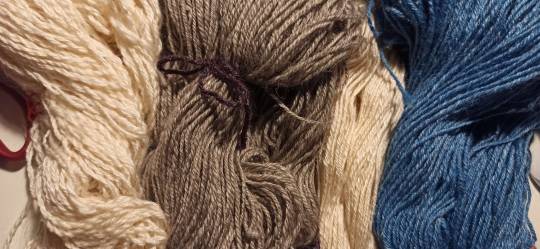
Fiber arts update: I finally finished the accursed yarn for the goddamn weaving project!
(this also counts as 100 days of art, 35/100 on the grounds of fiber arts still being art. I think I deserve that after the annoyance this project put me through so far...)
The white stuff is 50/50 silk/polwarth, the blue stuff is 30/70 silk/merino, and the grey one is 20/20/60 yak hair/silk/polwarth.
The yak hair was lovely to work with, the merino was frankly just a bit boring, and the polwarth/silk was the actual bane of my entire existence for months. I will never manage to un-fuzz my room after the goddamn silk tornado that fiber let loose, and there were a bunch of little silk clumps in there that made the spinning experience just deeply un-fun. Ngl, I never enjoy spinning 50% silk blends, and I do not know why I keep doing it.
(it's silky and shiny and has so much drape, that's why)
Anyway, it's on my loom now:
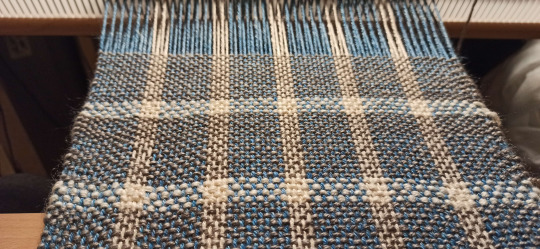
I was so happy about how well the warping went, until I realized that I did it backwards and spent so very long fixing that. Worked out alright in the end, though.
top-down view (sideways, so I don't stretch your dash more than needed) for a better idea of the colors:
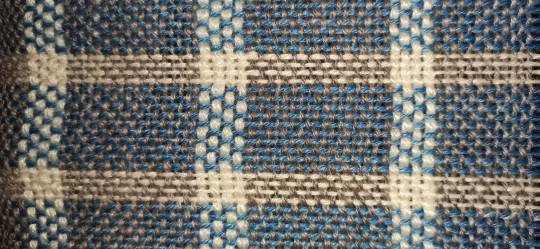
I wish the blue wasn't getting quite so overpowered by the relatively warm grey, but using more exciting colors would've meant using more boring fibers, and in the end I wanted to make it fancy more than I wanted to make it colorful.
I had a pretty difficult call to make with the white weft yarn; that's a 6-ply; I had planned for 4-ply worsted-spun warp and 3-ply woolen-ish weft to account for my habit of long-draw singles always coming out a bit chunkier, but the polwarth/silk didn't quite cooperate and the yarn was generally looking kind of wispy and sad, so I loosely cabled it... which made it chunkier than the other weft yarn, but I just decided to own it. It does add some sorely needed contrast and structure, I think.
#handspun yarn#yarn spinning#hand spinning#the100dayproject#the 100 day project#guardy's 100 days of art#hand weaving#rigid heddle loom#rigid heddle weaving#guardy's fiber arts tag
72 notes
·
View notes
Text
I finally soaked and thwacked a bunch of yarns that had been lying around for quite a while 💕

First, we have, with blue and red and purplish, the Mondschaf fluff which i had started back in 2022. I think there's one last bunch of combed top left somewhere waiting to be spun xD (talk about slow fashion xD)
I'm pretty sure it's merino, or at least has merino in it.... 😅 Also, it's chainplied.

And next, up with blue, yellow and white, is a two-ply yarn. The blue and yellow are from a merino/silk mix combed top which i bought bc the colours reminded me of my favourite di'kut and fridge-shaped blue tin can man, Paz Viszla.
Please behold:

I've been separating the colours to keep them as bright and clear as possible 🥲 it's a lot of work, but i do think it's worth it.
The white is alpaca from my home town and supposed to be at least somewhat reminiscent of Paz's flight suit colour. It's from an alpaca called Emma! ^_^
I do have brown and black alpaca fluff, too, and I'm thinking of incorporating these as well...
The alpaca fluffs have been washed and carded, but there's still too much VM for my taste, so I've been using my hand cards and tweezers to get as much out as possible, making fluffy little clouds to spin up once in a while.
This is the thinnest yarn I've ever made. I did not plan on it, it just happened with the fibers, so I guess that's how it will be.
Also, it's one of the rare spinning project where i have an actual crafting project in mind! I want to knit a very simple but big triangle scarf, to wrap myself up in (and daydream about the blue di'kut (my beloved)).
51 notes
·
View notes
Text


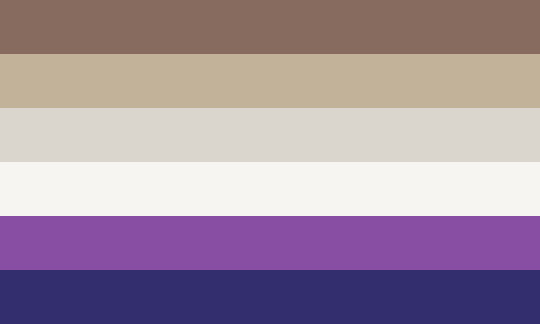

flag id: three flags with 6 stripes. the left flag's stripes are soft brown, tan, beige, off-white, faded red-pink, and medium dark pink. the middle flag's stripes are soft brown, tan, beige, off-white, dull green, and medium dark blue. the right flag's stripes are soft brown, tan, beige, off-white, dark faded purple, and very dark blue. end id.
banner id: a 1600x200 teal banner with the words ‘please read my dni before interacting. those on my / dni may still use my terms, so do not recoin them.’ in large white text in the center. the text takes up two lines, split at the slash. end id.
suffolk sophian | ram jamian | merino rowanian
suffolk sophian: a sophian who prefers cuddles, kisses, etc. over sex
merino jamian: a jamian who prefers cuddles, kisses, etc. over sex
sheep rowanian: a rowanian who prefers cuddles, kisses, etc. over sex
[pt: suffolk sophian: a sophian who prefers cuddles, kisses, etc. over sex
merino jamian: a jamian who prefers cuddles, kisses, etc. over sex
sheep rowanian: a rowanian who prefers cuddles, kisses, etc. over sex. end pt]
sophian, jamian, and rowanian equivalents to bambi lesbian! anon asked for the sophian and rowanian terms and i figured i'd also do jamian. they suggested sheep rowanian, so i used suffolk and merino, two very common types of sheep, for sophian and jamian.
tags: @radiomogai | dni link
#suffolk sophian#merino jamian#sheep rowanian#sophian#jamian#rowanian#my flags#my terms#new flag#new term#mogai flag#mogai term#mogai
51 notes
·
View notes